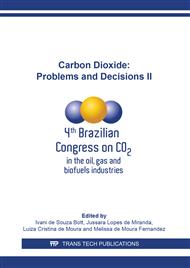p.21
p.29
p.39
p.49
p.59
p.69
p.79
p.87
p.97
CO2 Emission and Energy Assessments of a Novel Pre-Purification Unit for Cryogenic Air Separation Using Supersonic Separator
Abstract:
Thermal power plants with oxy-combustion CO2 capture are featured by large scale oxygen demand, where cryogenic air separation is most suitable. In such context, a Pre-Purification Unit (PPU) is required, prior to air fractionation, to remove hazardous air contaminants – H2O, CO2 and several trace-species – preventing ingress into the Cold Box. The conventional PPU – named FULL-TSA – remove those contaminants by means of Temperature Swing Adsorption (TSA), ordinarily using double-layered bed with activated alumina for adsorbing H2O and zeolitic molecular sieve for adsorbing CO2 and further trace-species, which implicates in relatively high demand of low-pressure steam for impurities desorption. A novel pre-purification concept (SS-TSA) embraces a Supersonic Separator (SS) performing the bulk of separation service, abating nearly 98.5% of H2O, followed by a finishing single-bed molecular sieve (MS) TSA step, which is featured by its relatively small size, for removing CO2 and remaining impurities. This work presents the energy analysis, as well as the related indirect CO2 emissions, of such a novel concept (SS-TSA) comprising air compression, cooling, SS dehydration and finishing MS-TSA against the conventional method fully based in TSA purification (FULL-TSA). Process simulation in HYSYS 8.8 assisted technical evaluation and comparison of alternatives, which included the use of two Hysys Unit Operation Extensions – SS-UOE and PEC-UOE – for rigorous thermodynamic SS modeling with phase equilibrium sound speed. SS was designed to impose only 1.4% of head loss, while shrinking TSA service to about 10% of FULL-TSA counterpart, also recovering super-cooled aqueous condensate that reduces water make-up and N2 consumption for cooling. Changing from FULL-TSA to SS-TSA the average demand of low-pressure steam reduced from 1.37 to 0.16 MW. In terms of electricity demand the difference was quite small, referring to a tiny increase of 0.07 MW in SS-TSA comparatively to total power demand of 14.97 MW in FULL-TSA. Assuming a natural gas combined cycle cogeneration plant matching requirements to air compression and pre-purification process, equivalent reduction in CO2 indirect emission was 20 kg/h for SS-TSA. These results point superiority of SS-TSA.
Info:
Periodical:
Pages:
59-67
Citation:
Online since:
July 2019
Price:
Сopyright:
© 2019 Trans Tech Publications Ltd. All Rights Reserved
Share:
Citation:


